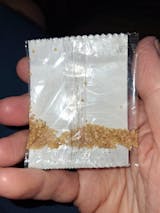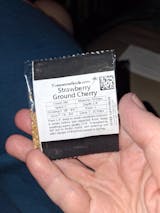
Strawberry Ground Cherry
$3.95
100%
Non-GMO
Free
Shipping
Service
Guaranteed
Also Known As: Dwarf Cape Gooseberry, Physalis, Strawberry Tomato, Pineapple Ground Cherry, Aunt Molly's Ground Cherry, Groundcherry, Poha Berry.
| Plant Name: | Ground Cherry, Strawberry |
| Latin Name: | Physalis pruinosa |
| Days to Germinate: | 7-21 |
| Days to Harvest: | 70 |
| Plant Height: | 18 - 24 Inches |
| Spread: | 18 - 24 Inches |
| Growth Habit: | Bush, Indeterminate |
| USDA Zones: | 5-11 |
| Lifespan: | Annual |
| Brand: | TomorrowSeeds |
| Sunlight: | Full Sun, Partial Shade |
| Pollination: | Heirloom, Open-Pollinated |
| GMO: | No |
| Fungicide-Treated Seeds*: | No |
| Seeds Packed For**: | 2025 |
**Seeds are freshly packed for the growing season of the year listed. Seeds are still viable beyond pack date. Store in a cool and dry location such as the refrigerator or basement to best preserve germination rates.
Planting Instructions:
Soil Preparation:
Choose an area with heavy, well-draining soil that receives at least 6 hours of sunlight each day. Remove weeds, large rocks, and litter from the planting area. Leave small weeds and dead grass, they will enrich the soil when turned under. Spade or till the soil 8-12 inches deep. Loosening the soil will help the plant establish strong roots.
Plants grow best in soil with lots of organic matter. You may optionally add fertilizer or organic material such as compost, leaves, or rotted hay to mix into the soil at this point. For small gardens, scatter 2-3 tablespoons of a complete fertilizer evenly and work into the top 2-3 inches of soil for each hill or 2 foot by 2 foot planting area. For larger gardens, scatter 2-3 pounds of a complete fertilizer for each 100 square feet of planting area. Work fertilizer or organic material into the soil and leave the surface smooth.
Form rows of soil beds 4-6 inches high and at least 2 feet apart. This formation of ridges will help with drainage.
Planting:
Ground Cherries grow best in warm weather (65F-85F).Starting Indoors: For an earlier harvest, you may optionally start planting indoors in containers 6-8 weeks before the last expected frost date in Spring, keeping seedlings at least 70F. Harden off then transplant seedlings outdoors in a sunny location when the soil temperature is above 65F. To transplant seedlings, prepare a transplant hole outdoors in a sunny location. Remove the plants carefully from the pots or flats and set them in the holes, burying some of the stem in the ground. Pack the soil loosely around the plant and leave a slightly sunken area around each plant to hold water. Water the plants after transplanting.
Directly Sowing: If directly sowing Ground Cherries outdoors, plant after all danger of frost has passed in spring and soil temperatures reach at least 65F. If fall planting in cold climates, sow in containers at least 8-10 weeks before the first expected frost, but bring indoors before the first frost and keep in a bright location.
To plant, make holes 1/4 inch deep and spaced 2 feet apart down the rows of raised beds. Plant 2-3 seeds per hole. If choosing to thin to the strongest plant, determine the strongest and healthiest plant, then remove all other plants, narrowing to a single plant per hole. Cover seeds thinly with soil and water after planting.
| Planting Depth: | 1/4 inch |
| Within-Row Spacing: | 2 feet |
| Between-Row Spacing: | 2-3 feet |
Care During the Season:
Watering: Water the plants deeply, soaking the soil to a depth of 6-8 inches, once to twice a week. If there is no rainfall, water 3-4 times a week. Sandy soils may need to be watered more often than heavy clay soils. Mulching around plants can help retain moisture.
Weeding: Keeping plants weed-free improves production. If plowing or hoeing, do not dig deeper than 1 inch to prevent from cutting the feeder roots.
Fertilizing: Once seedlings are established, 2-3 weeks after germination, you may optionally apply 2 tablespoons of a complete fertilizer around each hole, or 1-2 pounds per 100 square feet, without letting the fertilizer touch the plants. Optionally, continue fertilizing every 1-2 weeks as plants grow. Water plants after fertilizing.
Insecticides: Insecticides may be used to protect plants. Bt-based insecticides and sulfur are organic options that can be used for prevention. Sulfur also has fungicidal properties and helps in controlling many diseases. Before using a pesticide, read the label and follow cautions, warnings and directions.
Diseases: If spots or mold appear, treat plants with an approved fungicide. Neem oil, sulfur, and other fungicides may be used. When using fungicides always follow label directions.
Harvesting:
Ground Cherry plants begin bearing fruit 65-85 days after seeding and continue for 1-2 months or until the first frost. The fruit is ripe when the papery husk turns a light tan or straw color, and the berry inside turns golden-yellow or orange. A key indicator of ripeness is that the fruit will naturally fall to the ground when ready. For best quality, pick fruits just as the husk, or calyx, bursts. Avoid harvesting green, unripe fruits. Once harvested, remove the husks and store the berries in a cool, dry place, where they can last for several weeks.



















